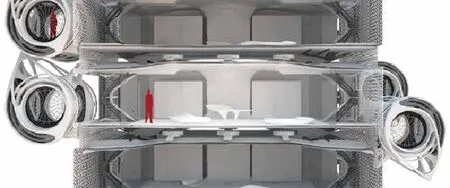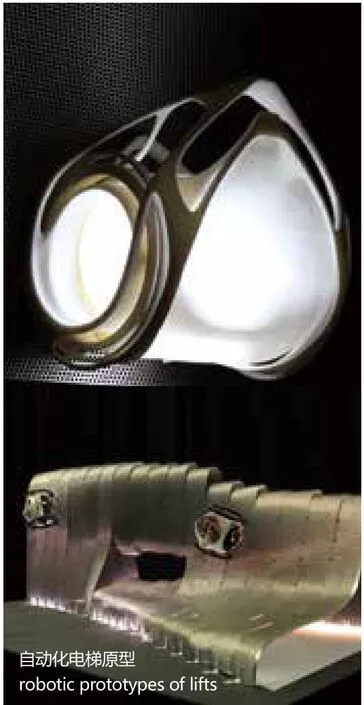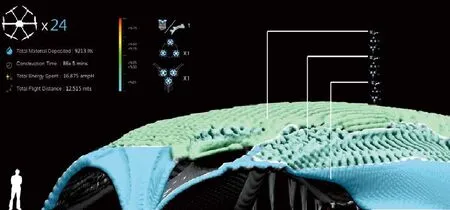lif[e]t:自主和网络化建筑
2015-03-02学生组CIA陈天一杨皓程杨磊VineethKannoth
学生组:CIA (陈天一,杨皓程,杨磊,Vineeth Kannoth)
导师: Robert Stuart-Smith
工作室技术顾问:Tyson Hosmer
lif[e]t:自主和网络化建筑
学生组:CIA (陈天一,杨皓程,杨磊,Vineeth Kannoth)
导师: Robert Stuart-Smith
工作室技术顾问:Tyson Hosmer

气孔性建筑流线优化算法决定建筑网络化结构stigmergic building circulation optimisation algorithm determines building network configuration

建筑节点利用了位相多样体 ,确定流线能通过建筑各交汇点并能够到达建筑的另一面building junctions utilise topological manifolds to ensure circulation can continue past junctions and allow crossing to opposite facades of building

鸟瞰图展示在城市尺度下的建筑,提供了大量的可活动的底层空间aerial view of part of the porous urban-scale architecture that leaves most of the ground free for recreation

模拟的自主运行的电梯与交互式立面屏幕simulation of autonomous lifts and responsive facade screen
之前的项目具有清晰的寿命周期,着重在制造、装配和时间环境设计方面进行研究探索。而本项目主要关注流线持续的时间活动性,并对其在当前建筑类型学中发挥的作用作进一步研究。本项目提出了一种新的建筑类型及其城市应用前景,以当今科技所能实现的更灵活的分散式机器人系统取代现有的流线概念。这项研究认为建筑物内的核心体式和走廊式流线往往是不太理想、被浪费的空间。通过将流线转移到立面,产生了一种新的电梯设计,既可用作建筑的电梯,又可在街道上运行。在这样情况下,建筑物不是以单体出现,而是形成一个自身连续的流线网络,那么这样设计的城市将会更加高效。使用连续立面作为建筑流线的基础设施,在此立面上,大量分散式的半自动电梯能够沿其表面在任何方向上自由移动。这项设计研究主要提出一种数字化设计方法,这种方法利用基于蚂蚁算法的群体搭建原理对3D流线进行优化,从而提供一个与费雷•奥托开发的网络相似的最佳最小环绕网络。此外还为电梯系统开发了一种基于集群模拟的算法,这种算法结合了迪杰斯特拉研究的算法,用于查找多个地点之间的最短路径。每台电梯分别寻找与其目的地之间的最短距离,同时利用局部避绕和集群原理来确保在立面的有效交通流线。立面是动态运行的,可以从一个的完全开敞的位置(便于良好视野),到一个被穿孔金属板完全封闭的位置(以便自动化电梯在其表面通过)。这些状态之间的转换,使立面一时充满生机,为项目增添了定性设计价值。该项目体现了一种快速而高效的都市风格,尽可能减少离开一个空间到抵达另一个建筑空间之间的时间延误。
-- TEMPORAL DESIGN --LIF[E]T: AUTONOMOUS & NETWORKED ARCHITECTURE
STUDENTS: CIA: TIANYI CHEN, HAOCHENG YANG, LEI YANG, VINEETH KANNOTH
SUPERVISOR: ROBERT STUART-SMITH
STUDIO TECHNICAL CONSULTANT: TYSON HOSMER
The previous project’s articulated life-cycles that explored fabrication, assembly and temporal environmental design. This project focused on the continuous temporal activity of circulation and challenged its role in current building typologies. A new building typology and its urban potentials were developed that replaced existing notions of circulation with a more flexible distributed robotic system achievable using today’s technology. The research identified that lift core and corridor circulations within buildings tend to be undesirable and wasteful spaces. By shifting circulation to the facade, a new lift design emerged that was capable of operating as both lift-core and street. This suggested that urban design could operate more efficiently if buildings were not considered separate entities but formed a continuous circulatory network themselves. Continuous facades operate as the circulation infrastructure upon which a distributed multitude of semi-autonomous lifts are able to move freely in any direction along its surface. The design research focused on developing a digital design methodology that optimised 3d circulation using ant-based stigmergic principles that provided an optimal minimum-detour network similar to those developed by Frei Otto. An agent-based algorithm was also developed for the lift system that incorporated Dijkstra’s Algorithm for finding the shortest path between numerous options. Each lift independently seeks the shortest distance to its destination whilst employing local avoidance and flocking principles to ensure efficient traffic flow across facades. The facade kinetically operates between an open position for clear views and a closed perforated facade that enables the autonomous lifts to pass across its surface. The switching between these states animates the facade in a temporal manner that adds qualitative design value to the project. The project enables a rapid and efficient urbanity where there is minimal delay between departing one built space and arriving in another.

项目的标准建筑剖面,展示一种没有室内交通流线的浅进深建筑typical building section showing a shallow-depth building with no internal circulation

立面屏幕的自动化原型robotic prototype of facade screen

立面屏幕开启与关闭取决于临近的依靠建筑表面运行的自动化电梯轨迹facade screen opens and closes in relation to the proximity of autonomous lifts which utilise its surface to move across the building

自动化电梯原型robotic prototypes of lifts

渲染图表明电梯通过建筑立面连接室内空间render showing the autonomous lift connecting to an interior space through the facade

整体建筑/总体鸟瞰图:建筑长约4个城市街区,确保了建筑覆盖区域的主要部分底层空间的自由性Overall building / masterplan aerial view:The building is approximately 4 city blocks long and keeps the majority of the ground level free from roads or building footprint

建筑体的空隙率与材料的纹理方向随着机器人建造的局部行为而定the building geometry varies locally in porosity and material grain direction due to the local behaviours of the robotic construction team

室内效果图:肋架天花为建筑提供额外的结构硬度interior visualisation:the ribbed ceiling provides additional structural stiffness to the building
